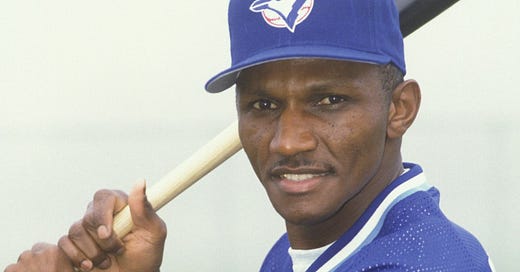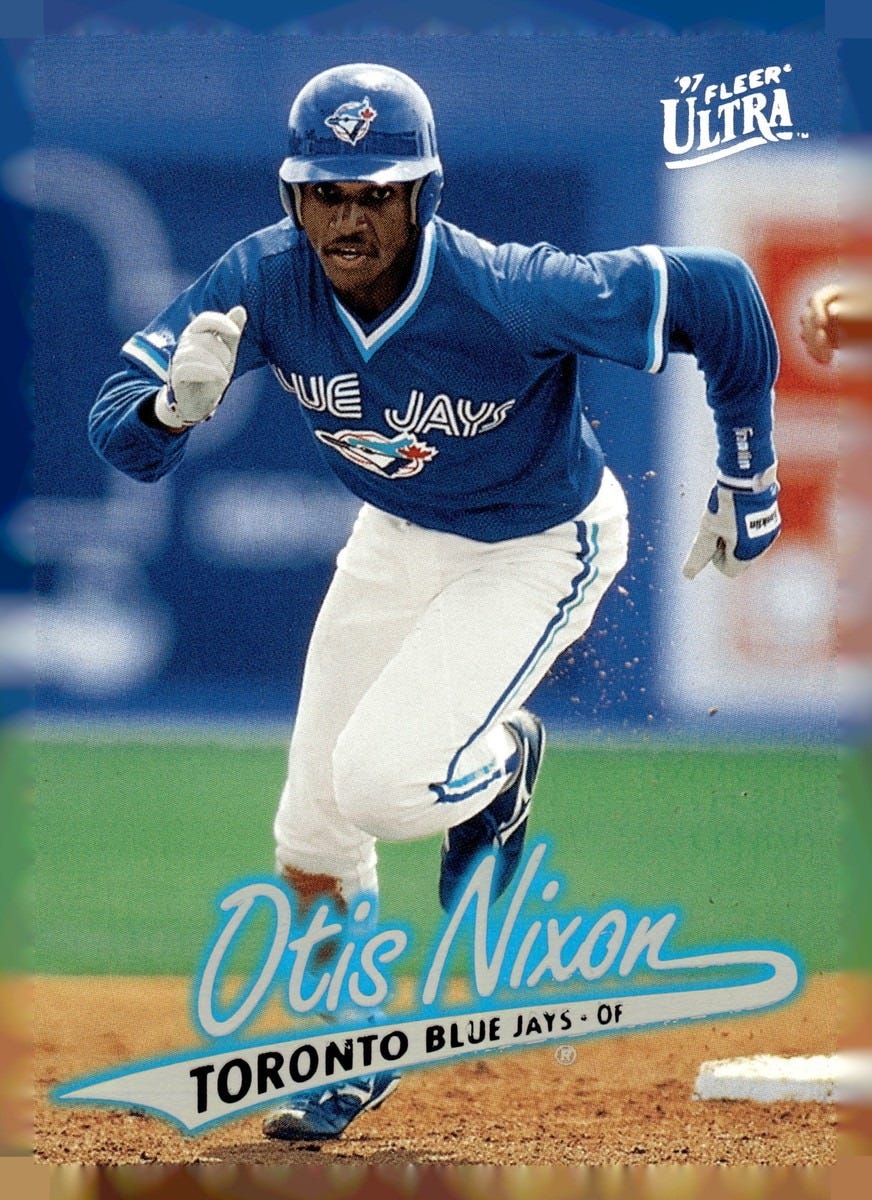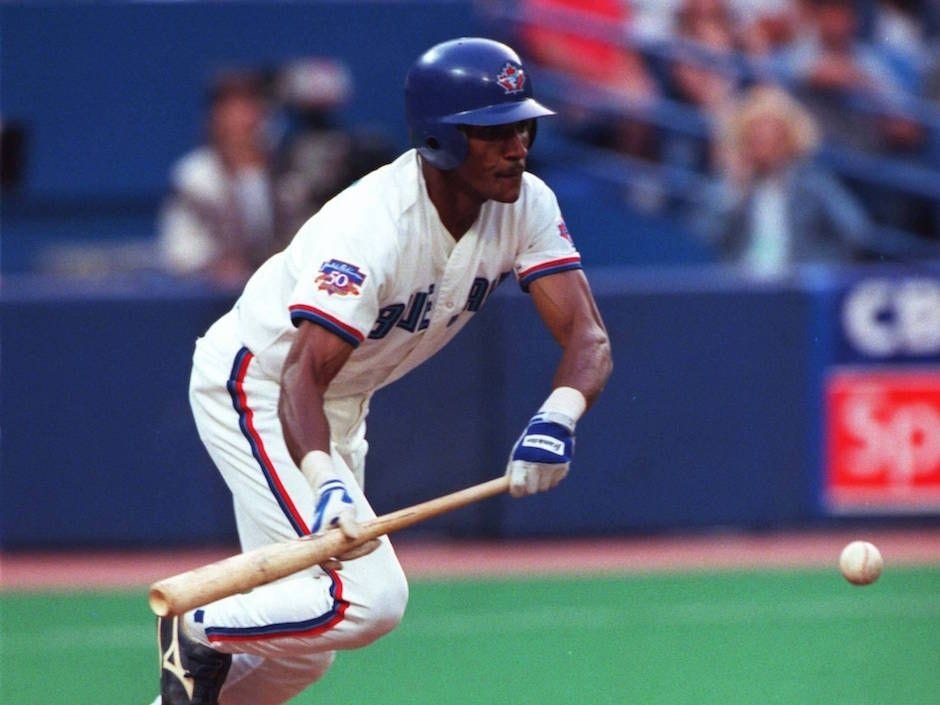Were one to think about the Blue Jays and base stealing, the first names to jump to mind would surely be Roberto Alomar, Rajai Davis, Lloyd Moseby, Devon White, and perhaps, by virtue of his entire career and not just his two-month sojourn in Toronto, Rickey Henderson. Vociferous readers of this very Substack, and fellow baseball dorks, might also be heard screaming the name, Dave Collins! Every one of these players, and several more still, were excellent base stealers with a Toronto franchise not historically known for harbouring elite thieves. However, one name might get passed over more often than not. Otis Nixon''s time in Toronto was short - just a couple months shy of two full seasons between 1996 and 1997. But in that span, he put himself firmly in the Blue Jay history books as one of the team's greatest all-time base stealers.
Long before he arrived in Toronto, Nixon debuted as a twenty-four year old with the New York Yankees in 1983. He only appeared in thirteen games, totalling two singles and a walk in fifteen plate appearances, and going two-for-two in stolen base attempts. That offseason, he was dealt to Cleveland, where he played in a part-time role for four seasons. Inconsistent playing time clearly hurt Nixon's production, as he posted a paltry .214/.276/.266 slash line, and stole only fifty-seven bases at a problematic sixty-eight percent success rate. He signed with the Montreal Expos ahead of the 1988 season and for three more years he was, yet again, a part-time player, albeit a far more valuable one than in his previous five seasons. During his tenure in Montreal, Nixon registered an on base percentage above .300, and stole 133 bases at a much-improved 77.8 percent success rate.
To this point in Nixon's career, he had amassed 192 stolen bases over the span of eight seasons. That total is nothing to sniff at, but given the base stealing trends of the run-wild 1980s, it ranks him only twenty-fourth among baseball's top thieves between 1983 and 1990. For context, here are the top ten base stealers from that span:
Rickey Henderson (617)
Vince Coleman (549)
Tim Raines (478)
Brett Butler (328)
Willie Wilson (325)
Steve Sax (322)
Juan Samuel (318)
Gary Pettis (311)
Ozzie Smith (292)
Gary Redus (279)
Certainly, the cream of the crop (Henderson, Coleman, Raines) were far and away better than everyone else on this list. After those three, the number of steals drops precipitously and declines at a fairly steady rate from there. What makes Nixon such a compelling figure among the top base stealers between 1983 and 1990 is that he made it relatively high on that list with significantly fewer games played and plate appearances than anyone around him. He only made it into 625 games in that window, totalling just 1,283 plate appearances. The next nearest player on the stolen base leaderboard who was active from 1983 to 1990 and played in fewer games is Cecil Espy with ninety-one stolen bases over 1,006 plate appearances in 351 games, ranking him at number seventy-five on the list. Further, even with so few plate appearances, Nixon compiled a 12.7 weighted stolen base average, which ranks him twenty-fifth over that span. And he did all of this while stealing at a just-barely-acceptable seventy-five percent success rate.
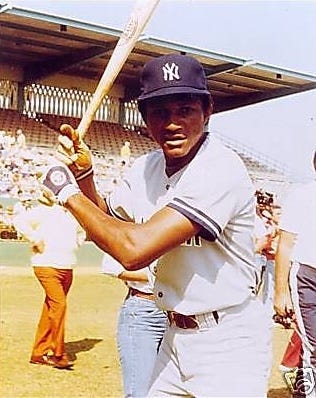
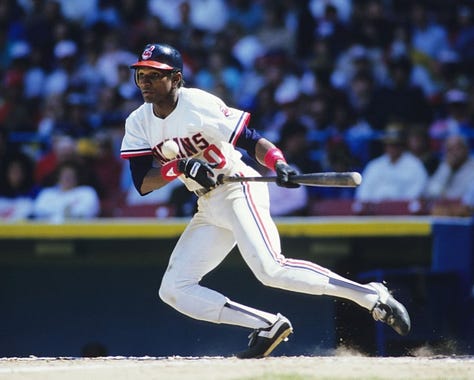
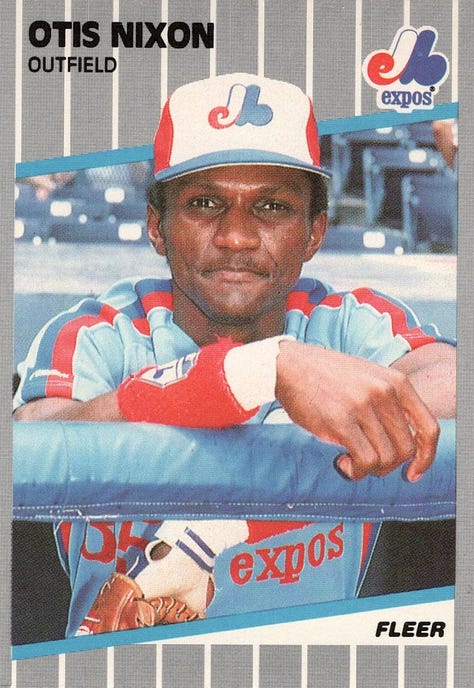
The specialization of Nixon's skillset became obvious during these first years of his career as he managed to hang around for eight seasons, creating all of this value with his legs while putting up a measly 64 OPS+. Using the same list of top base stealers between 1983 and 1990, the next lowest OPS+ accrued during that exact span belongs to number 307 on the list, Steve Jeltz, and his 61 OPS+ (he had eighteen stolen bases over 2,041 plate appearances in 727 games). Nixon was not a potent bat, nor a particularly special fielder. His worth was wrapped up entirely on his base-stealing prowess, which was good enough to keep him consistently employed in the Major Leagues.
Then 1991 rolled around, and Nixon was fortuitously traded to Atlanta just ahead of the start of the season. Bobby Cox's nascent dynasty gave Nixon a fair shake as the everyday centre fielder and leadoff hitter. Nixon flourished, and became a central cog for a team rolling to the pennant after finishing in last place the year before. During his three seasons in Atlanta, the team made its way into the World Series in 1991 and 1992 (Blue Jay fans will remember Nixon as the final out of the 1992 Series), and the NLCS in 1993. One highlight from this era that Atlanta fans will carry with them forever is Nixon's game-saving, home run-robbing catch during a late-July game in 1992 against the rival Pirates. That catch seemingly propelled his team out of a funk and towards another division title.
Despite a 1991 drug-related suspension (which kept Nixon out of the 1991 World Series and ate into his 1992 campaign), Nixon enjoyed the three greatest seasons of his career while with Atlanta. He put up 8.3 bWAR, slashed .286/.356/.329, and stole 160 bases at a 75.5 percent success rate with a wSB mark of 11.4. After his three excellent seasons in Atlanta, Nixon signed as a thirty-five year old free agent with the Red Sox. Yet again, he enjoyed a great, albeit strike-shortened, 1994 season as the starting centre fielder and leadoff hitter in Boston. He was then flipped to Texas in a deal for José Canseco, and had another great season, his fifth in a row, while setting a career high with 174 hits.

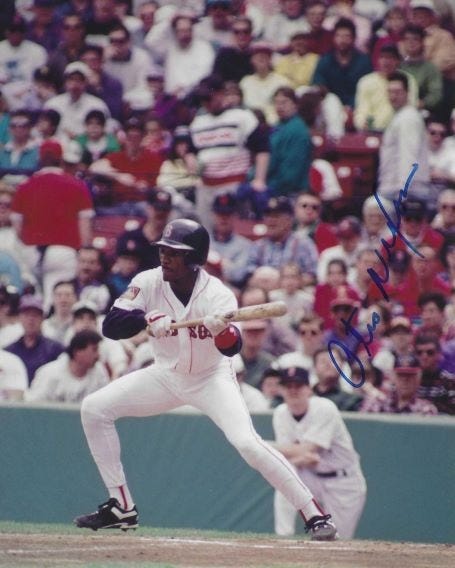

Ahead of the 1996 season, Nixon signed a two-year free agent contract with the Blue Jays to fill the centre field hole created after the departure of Devon White. The Blue Jays trudged through a tough season in a newly dominant American League East. The dying embers of Toronto's championship teams of the early 1990s were joined by some raw, young talent. The resulting mix revealed many inconsistencies. John Olerud, Ed Sprague, Juan Guzman, and Mike Timlin all had fine seasons, while Pat Hentgen won that year's Cy Young Award. But Carlos Delgado, Shawn Green, and Alex Gonzalez were relied upon to supply a good chunk of the offense, and it was clear that each needed more time to get their Major League feet under them.
Among this mishmash of old and new Blue Jay legacies, thirty-seven year old newcomer Otis Nixon would be the oldest member of the Jays in 1996. And he had another fine season as the primary centre fielder and leadoff hitter. He registered his highest on-base percentage with a .377 mark, while he stole 54 bases at an excellent 80.6 percent success rate, with a wSB of 4.8, the third best of his career. The following season would be more of the same for Nixon, and more of the same, if not worse, for the Jays. Toronto finished the year in last place in the division, while Nixon, now thirty-eight years old, continued to supply on-base ability and speed at the top of the order. Before an August trade to the Dodgers (which netted the Jays minor leaguer, Bobby Cripps), Nixon had stolen forty-seven bases at an 82.5 percent success rate with a 5.1 wSB. When the full season wrapped, Nixon had nabbed fifty-nine bases at an 83.1 percent success rate with a career-high 6.7 wSB.
Entering his age thirty-nine season, Nixon signed with the Minnesota Twins and had what might have been considered at the time to be a standard-issue Otis Nixon campaign. He played centre field and batted leadoff for the Twins, collecting 133 hits and thirty-seven stolen bases along the way. He then returned to Atlanta for the 1999 season, and for the first time in nine years, resumed his role as a backup, this time to Andruw Jones. Though his slash line regressed significantly, in only eighty-four games, he still managed twenty-six stolen bases. He rejoined a team that was firmly in the middle of a dynastic run, winning the National League pennant for the fifth time in nine seasons. Nixon was rostered during all three rounds of the playoffs, including the World Series, which ended as a sweep at the hands of the Yankees. After receiving no interest from teams in the offseason, Nixon decided to hang up his spikes for good. He retired with 620 career stolen bases, ranking him sixteenth all-time, just ahead of George Davis, and two behind Kenny Lofton. His 46.5 career wSB puts him at twenty-fifth all-time, one tenth of a point behind Paul Molitor and Ichiro Suzuki.
Otis Nixon's career is a story told in two contrasting halves. His first eight years in the Majors were spent primarily as a backup, but, as was demonstrated above, he still managed to make himself a valuable base stealer. The second half of his career started in Atlanta at the age of thirty-two, and he proved to be a dependable leadoff hitter, slashing .281/.355/.325 with 428 stolen bases at a 77.8 percent success rate over his final nine seasons.
During those final nine seasons, from 1991 to 1999, he amassed the second most stolen bases in the Majors. Over that span, here are the ten most prolific base stealers:
Kenny Lofton (433)
Otis Nixon (428)
Rickey Henderson (398)
Marquis Grissom (359)
Delino DeShields (351)
Chuck Knoblauch (335)
Craig Biggio (294)
Eric Young Sr. (292)
Barry Bonds (291)
Roberto Alomar (287)
And here's how Nixon ranks among that span's ten most valuable base stealers by wSB:
Kenny Lofton (40.3)
Rickey Henderson (35.0)
Otis Nixon (33.8)
Marquis Grissom (32.4)
Roberto Alomar (29.3)
Barry Larkin (28.7)
Tony Womack (26.4)
Chuck Knoblauch (24.6)
Barry Bonds (23.6)
Delino DeShields (22.8)
Only a few weeks younger than Rickey Henderson, Nixon shared Henderson's ability to literally outrun his age. The above lists both place Nixon and Henderson side by side from their age thirty-two to age forty seasons with much younger players, both dominating Major League basepaths. This late-career renaissance for Nixon piqued my curiosity – what if Nixon had been given the proper runway as a starter during his prime years? From the age of twenty-four to thirty-one, Nixon was a part-time player and was surely robbed of the chance to amass a much higher career stolen base total. Let's forge ahead into a thought experiment riding a wave of faulty logic – it'll be fun.

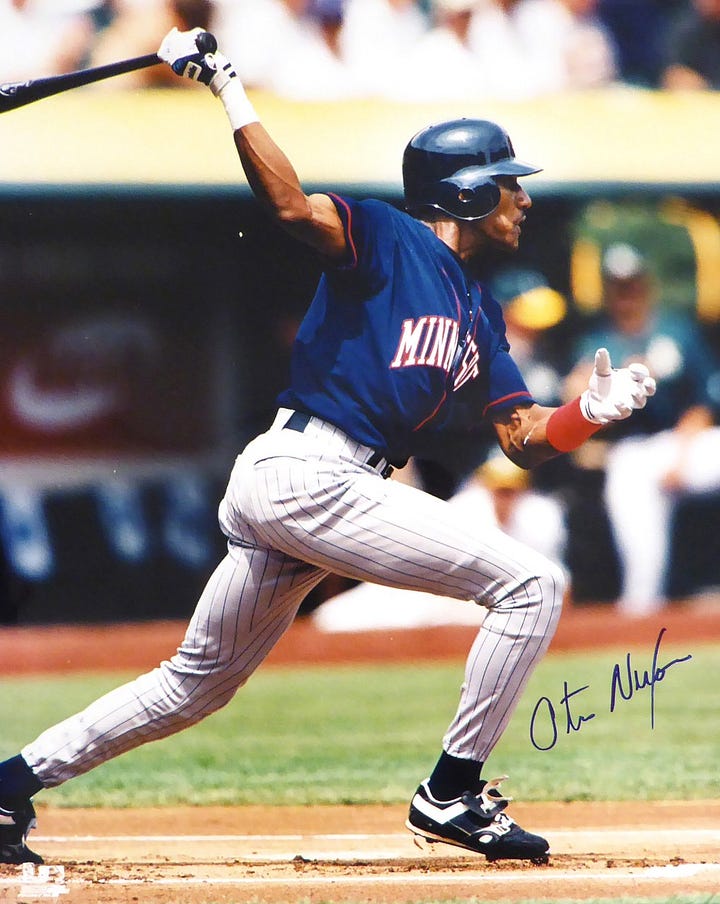
We can't know if Otis Nixon as an everyday player in his prime would have been a better or worse base stealer than he was later in his career. Perhaps he was a few steps faster in his youth, but maybe all of his veteran experience and savvy helped him get better reads and jumps after he turned thirty-two. For this thought experiment, let's just say he would have put up the same numbers from twenty-four to thirty-one as he did from thirty-two to forty (also assuming that his on-base abilities stayed consistent throughout his career). In the second half of his Major League tenure, he averaged 47.55 stolen bases per season. Because we're just having fun here, how about we round that up to 48 stolen bases per season. Now, let's plunk that per-season total into his first eight seasons giving him a new 1983-1990 total of 384 stolen bases. That amount would have bumped him all the way up to fourth place on the stolen base list during his prime years. Add this new total to his second-half total and he would have had 812 career stolen bases. That would be the fifth most all-time, behind Ty Cobb and ahead of Tim Raines.
Using the same logic, let's figure out Nixon's potential adjusted career wSB. During his final nine seasons, he averaged 3.8 wSB per season. Adjusting his first eight seasons with that average would give him a new career total of 64.2 wSB. And that would be the twelfth highest total in Major League history, just behind Tom Brown and well ahead of Bert Campaneris.. Had he not been relegated to backup duty through the first eight years of his Big League career, Otis Nixon may have been the fifth most prolific base stealer of all time, and the twelfth most valuable.
During Nixon's season and a half Blue Jay tenure, he put up the franchise's fourth best stolen base total in 1996, and its eighth best in his partial 1997 season. He finished the 1997 season with the Dodgers and ended up with fifty-nine stolen bases, one short of Dave Collins' Blue Jay franchise record. 1996 was also the ninth most valuable base stealing season in Toronto's history, while 1997 came in at seventh. However, Nixon's final wSB total in 1997, including his stint with the Dodgers, was 0.2 points higher than Dave Collins' franchise record of 6.5. If Nixon had finished the season in Toronto, he may well have had the second most prolific and most valuable base stealing season in Blue Jay history. Much like Collins, Nixon burned fast and bright on the basepaths for the Blue Jays. Both players' tenures in Toronto were brief, but both managed to assert themselves as franchise-leading base stealing threats. Unlike Collins, Nixon was a base stealing machine throughout his career, and can lay claim to being one of the greatest base stealers to ever pass through Toronto. Nixon's career wSB sits twenty-fifth all-time. The only players ahead of him on that list who have spent time as Toronto Blue Jays are Paul Molitor at twenty-third, and, of course, Rickey Henderson at number one.
As a player who never posted an OPS+ over 100, that Otis Nixon managed to play in the Major Leagues for seventeen years, the last nine of which were spent as a leadoff hitter and centre fielder, is a significant testament to the value of his particular skillset. His speed and base running instincts were so great that nine different teams were willing to carry his subpar bat. Even more remarkable, the majority of his production occurred between his age thirty-two and age forty seasons, ages during which most ballplayers decline significantly. Nixon's age-defying career was a marvel, and it followed an arc we don't see very often in this game. His is also the kind of career we may not see ever again. Teams don't grant starting jobs as leadoff hitters to speed only players. Nixon's career slugging percentage is twenty-nine points lower than his on-base percentage. This offensive profile doesn't find its way into too many Major League lineups, and certainly hasn't been a fixture at the top of any Major League order for many years now.
Likely as a result of the miserable Toronto teams of which he was a part, Otis Nixon is not readily remembered by many Blue Jay fans. But he was one of the greatest base stealers to ever call Skydome home, and even in his brief stay in Toronto, he put up two of the franchise's best base-stealing seasons. He was a compelling baseball figure over seventeen Big League seasons, and the Nixon archetype is a mostly extinct character in today's game. For Toronto to have played a role in the career of such a singular character is a joy for fans to remember, and we should readily and happily celebrate Otis Nixon's time with the Blue Jays.
Video
Nixon steals six bases in one game in 1991
Nixon's iconic game-saving home run robbery
Nixon walks it off for Atlanta
Nixon nabs the Atlanta season stolen base record
Mid at-bat sprinkler surprise for Nixon
Nixon with a great catch as a member of the Expos
Pat Borders nails Nixon during the 1992 World Series
Nixon picked off by Jimmy Key in the 1992 Series
Down to their last strike, Nixon ties Game Six of the 1992 World Series
Nixon was the last out of the 1992 World Series
Further Reading


